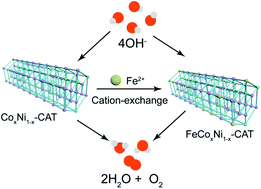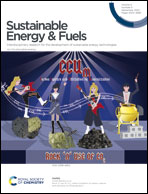Trimetallic conductive metal–organic frameworks as precatalysts for the oxygen evolution reaction with enhanced activity†
Abstract
Developing new precious-metal-free catalysts for the electrochemical oxygen evolution reaction (OER) is important for energy conversion and storage applications. Here, we report the preparation of a series of conductive M-CAT metal–organic frameworks (MOFs) (M3(HHTP)2, HHTP = 2,3,6,7,10,11-hexahydroxytriphenylene) and their utilization as a “precatalyst” for the OER in an alkaline electrolyte. The mono- and bimetallic CoxNi1−x-CATs were synthesized by a solvothermal reaction and further converted to the corresponding bi- and trimetallic FeCoxNi1−x-CATs via cation-exchange. Compared to its mono- and bimetallic counterparts, trimetallic FeCo0.6Ni0.4-CAT displays superior OER electrocatalytic performance with a low overpotential of 277 mV (to reach a current density of 10 mA cm−2), a small Tafel slope of 44.7 mV dec−1, a high TOF value of 0.2278 s−1, and excellent electrochemical durability. Our study indicates that metal oxyhydroxides were electrochemically formed under the alkaline aqueous OER conditions, which, instead of the pristine M-CATs, should contribute mainly to the enhanced OER activity.



 Please wait while we load your content...
Please wait while we load your content...